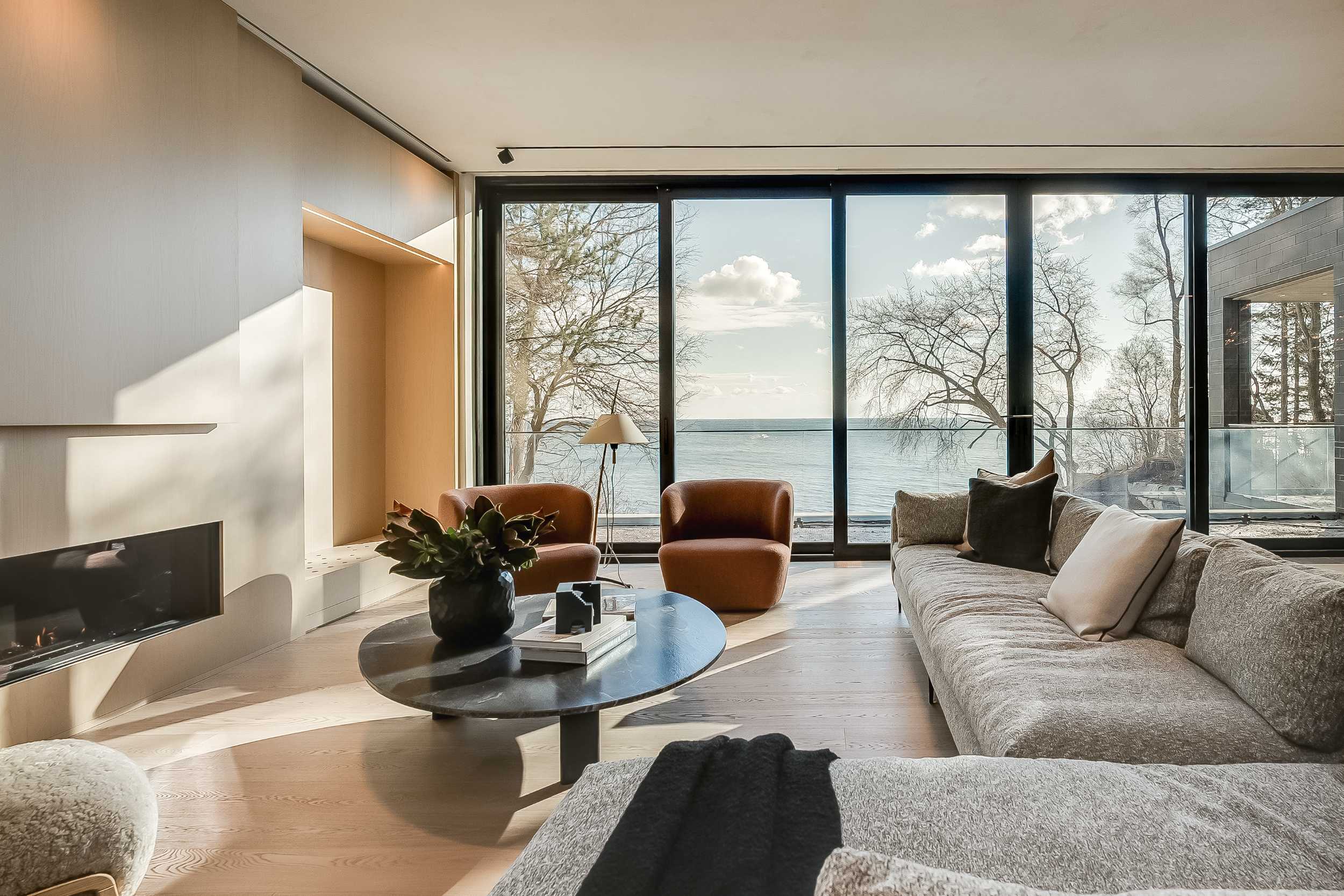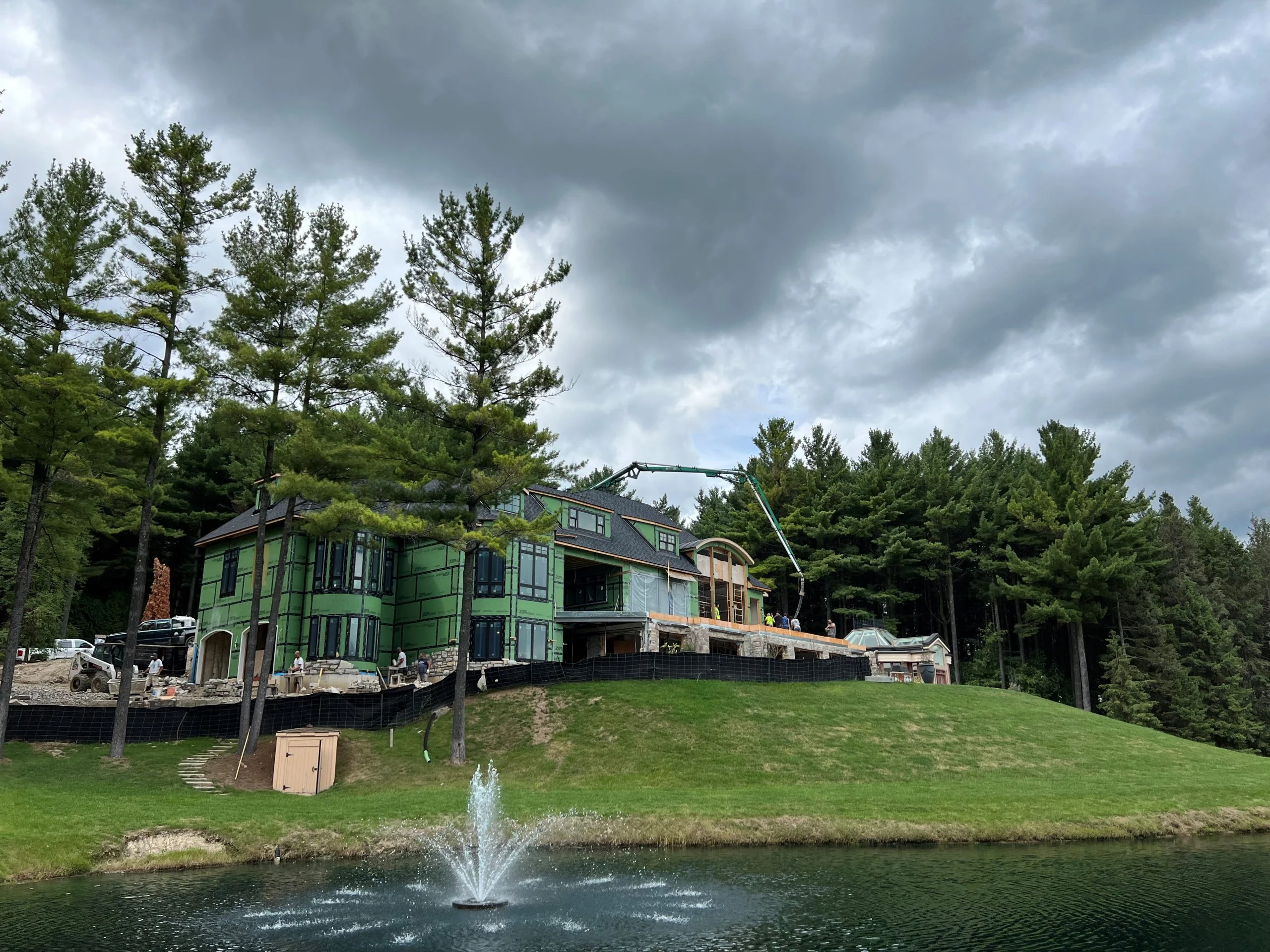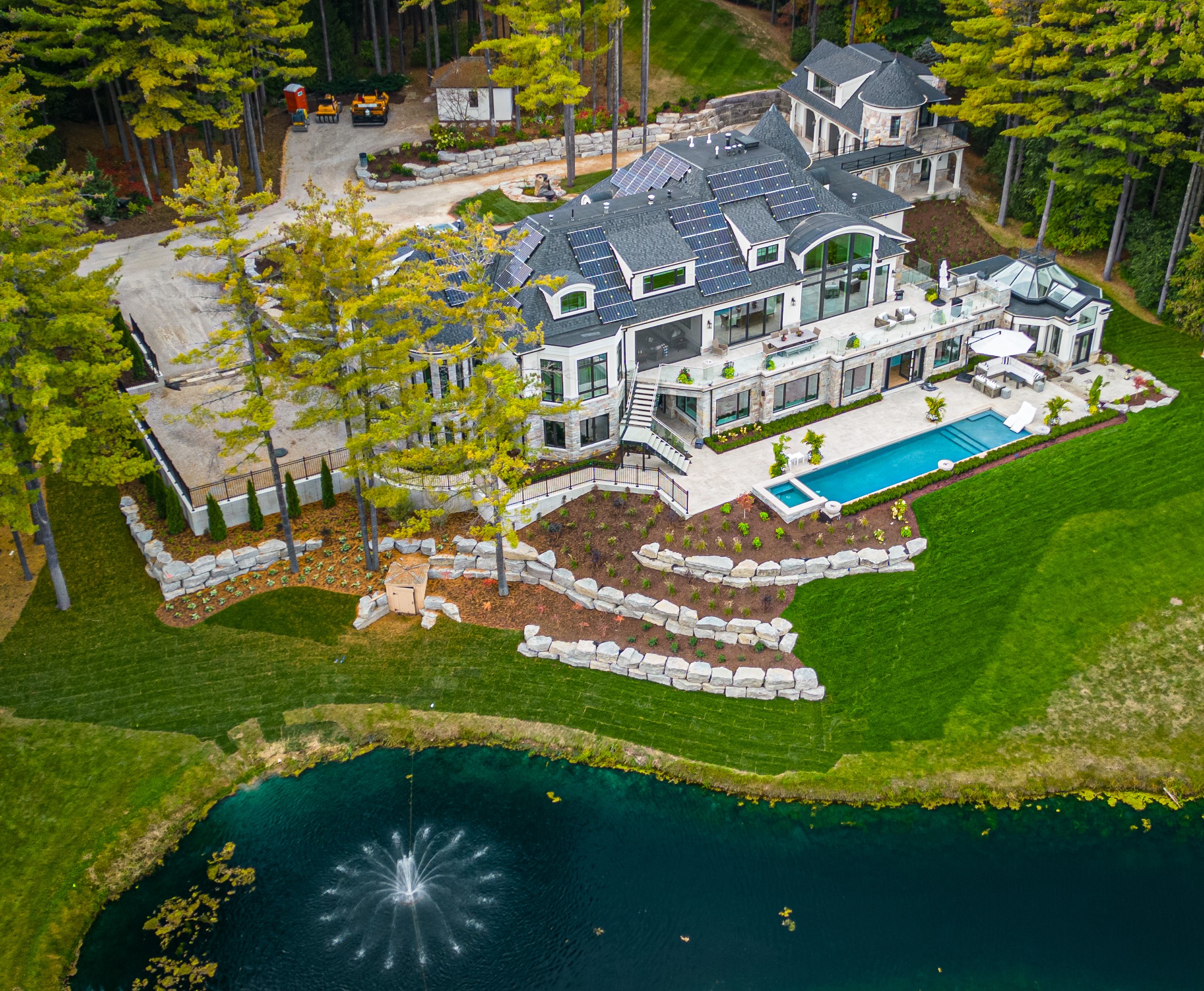Our team is poised with baited breath as the Building Excellence Awards approach and our West Oakville Lakefront NET ZERO project is a finalist! When it comes to green building our clients range from full adopters to curious and cautious. In this blog we’ll shed some light on NET ZERO homes and why they make sense.
the Green building seems enduring, as its not only reshaping our attitudes to sustainability but also tightening our building codes . And its here to stay! Every year we move towards cleaner standards and more energy efficiency. Reflecting on the past, it’s striking how our perspective on energy and construction has evolved. Picture the 1970s: big American cars guzzled fuel, and homes had no insulation. The oil crisis of that era sparked a shift, prompting government initiatives to enhance home energy efficiency.
Fast forward to the new millennium, and we’ve transcended those early steps. Modern vehicles boast fuel efficiency undreamed of in the past, and air conditioning, once a luxury, is now standard. Our homes? They’ve transformed into bastions of insulation and energy efficiency. This evolution isn’t just about technology; it’s about expectations. Especially in the realm of luxury custom homes, where the bar is continually raised, aligning with evolving building codes and consumer demands.
Our clients, navigating the complex landscape of green building options, seek clarity on their choices. They ponder the merits of various materials and technologies, from zip panels and triple-glazed windows to advanced HVAC systems and solar panels. Their questions are many, underscoring a keen interest in the return on investment and the environmental impact of their decisions.
In this blog, we’ll explain these options, drawing on our experiences and insights from Net Zero Energy Homes, an exemplar of energy efficiency and sustainable design. This home not only conserves energy but also stands as a testament to the future of residential construction, bringing luxury with responsibility.

Understanding the Concept of Green Building: Net Zero Energy Homes
Net zero energy homes are high-performance homes designed and built to produce as much energy as they consume. The concept of net zero homes is focused on reducing energy requirements, including renewable energy systems, and operating the home efficiently.
To achieve this, these homes start by reducing how much energy they need. This means they’re built with top-notch insulation, high-performance windows, efficient heating, ventilation, and air conditioning (HVAC) systems. This approach ensures that the home doesn’t need as much energy to begin with.
Then, these homes harness renewable energy sources to generate their clean energy. This could involve setting up solar panels, and wind turbines, or tapping into geothermal energy. This step is crucial because it helps the home produce its energy, offsetting what it uses.
Finally, living in a net zero ready home means being smart about how energy is used daily. It involves adopting energy-efficient habits and using technology like smart thermostats and energy monitors to keep an eye on and manage energy use. By staying on top of this, the home can keep its energy use and production in balance throughout the year.
Benefits of Net Zero Energy Homes
Also known as Net Zero Builds, Net Zero Energy Homes offers numerous benefits making them a desirable option for homeowners. They are designed to produce as much energy as they consume, reducing energy bills and carbon footprint. To understand the benefits better, we classify them into environmental, economic, and health benefits. let’s discuss each for better understanding.
Environmental Benefits
Green building practices have numerous environmental benefits that contribute to the overall sustainability of our planet. One significant benefit is the reduction of carbon emissions, which is achieved using renewable energy sources such as solar power and energy-efficient systems. By conserving resources such as water and materials, green buildings reduce the strain on natural ecosystems and promote responsible use of finite resources.
Additionally, green buildings often incorporate strategies for waste management, reducing the amount of waste sent to landfills and minimizing pollution caused by improper waste disposal. Green building initiatives also contribute to the conservation of biodiversity by using sustainable materials, preserving habitats, and providing green spaces for plants and wildlife. Overall, green building practices have a positive impact on the environment and are crucial for a more sustainable and resilient future.
Conservation Of Natural Resources
Conservation of natural resources is a vital aspect of green building, as it aims to minimize the consumption of resources and reduce the negative impact on the environment. This includes the efficient use of materials, such as using recycled or sustainable materials in construction and using renewable energy sources to power buildings.
Focusing on conservation allows green buildings to strive to reduce waste, preserve natural habitats, and promote ecological balance. Additionally, water conservation plays a crucial role in green building, with the implementation of strategies such as rainwater harvesting, low-flow fixtures, and water-efficient landscaping. The conservation of natural resources in green buildings not only benefits the environment but also contributes to energy savings, cost reduction, and improved sustainability for both residential and commercial structures.
Reduction in Greenhouse Gas Emissions
Reducing gas emissions in the context of green building plays an important role in mitigating climate change and promoting sustainability. net zero homes are designed to produce as much energy as they consume, resulting in minimal carbon emissions.
Reducing greenhouse gas emissions is crucial, and prioritizing energy efficiency in homes is a key strategy. This involves enhancing insulation, utilizing advanced HVAC systems, and choosing efficient appliances to lower energy requirements and cut down reliance on fossil fuels. Renewable energy sources, like solar panels, wind turbines, or geothermal systems, are essential for zero-energy homes, allowing homeowners to generate clean energy and decrease grid dependency.
The choice of construction materials also matters; selecting low carbon, recycled, or sustainable materials can significantly reduce the embodied carbon emissions linked to their production and transport.
Zero-energy homes are vital in the effort to minimize buildings’ carbon emissions, showcasing a practical solution to mitigate climate impact through energy efficiency, renewable energy adoption, and sustainable material usage, steering us toward a more sustainable future.
in a nutshell, green building practices have a positive impact on the environment, offering reduced carbon emissions, preservation of natural resources, mitigation of pollution, promotion of sustainable practices, and conservation of biodiversity. These practices are crucial for a more sustainable and resilient future.
Economic Benefits
Green building practices and technologies have significant economic benefits, contributing to growth, job creation, increased revenue, foreign investments, and an improved standard of living. The development and implementation of sustainable building practices require specialized skills and expertise, leading to job creation in areas such as construction, manufacturing of green materials, renewable energy systems installation, and energy auditing. Energy-efficient technologies and materials reduce operating costs for building owners and occupants, resulting in long-term savings on energy bills.

Lower Energy Bills
Zero-energy homes aim to reduce energy bills through efficient appliances, lighting, and smart technology. implementing Energy Star-certified appliances and LED lighting is key to minimizing energy use. Smart home technology further enhances energy optimization. Energy modelling, using computer simulations, identifies savings opportunities, guiding enhancements in insulation, windows, and HVAC systems.
Achieving zero energy certification, which requires third-party verification, signifies a home’s ability to produce as much renewable energy as it consumes, aligning with stringent energy performance standards. Implementing these strategies not only lowers energy costs but also promotes environmental sustainability, offering homeowners a chance to save financially while lessening their ecological footprint. Zero-energy homes stand as a testament to energy efficiency and sustainable living, merging economic benefits with environmental responsibility.
Improved Standards Of Living
Green buildings contribute to an improved standard of living. They provide healthier indoor environments, with better air quality, temperature control, and natural lighting. This leads to increased productivity, better health outcomes, and improved comfort for occupants. Sustainable building practices also contribute to reducing greenhouse gas emissions, mitigating climate change, and creating more resilient communities.
Increased Home Value
Investing in green building practices can significantly increase the value of a home. As consumers become more aware of the benefits of energy efficiency and sustainability, they are willing to pay a premium for homes that meet these standards. A net zero build, for example, can save over 50% in energy costs and command a handsome premium when it comes time to sell.
In addition to energy savings, green homes often offer enhanced comfort, better indoor air quality, and lower maintenance costs. These features not only make the home more attractive to potential buyers but also contribute to a higher resale value. By incorporating green technologies and building methods, homeowners can not only contribute to a healthier environment but also make a wise financial investment in their property.
Health Benefits
Energy-efficient windows in green buildings have numerous health benefits. They improve indoor air quality, prevent the infiltration of dust and allergens, and provide natural daylighting and views of the outdoors. Exposure to natural light has a positive impact on mood, productivity, and circadian rhythms.
Nature views can reduce stress levels and enhance cognitive function. These features promote a sense of well-being and create a more comfortable living environment. Overall, the health benefits of energy-efficient windows include improved physical health, enhanced mental well-being, and increased emotional comfort.
Improved Air Quality
Zero-energy homes are designed to be highly airtight for energy efficiency, but poor indoor air quality can occur without proper ventilation. To remove stagnant air and introduce fresh, filtered air, efficient ventilation systems are crucial in zero-energy homes. Heat recovery ventilation (HRV) and energy recovery ventilation (ERV) systems are key components that extract stale air and transfer heat from outgoing air to incoming fresh air, conserving energy and ensuring pleasant indoor temperatures.
Efficient ventilation systems offer numerous benefits, including reducing pollutant levels and preventing mould growth, ultimately fostering a healthier and more comfortable living environment. Therefore, maintaining good indoor air quality is essential for the well-being and comfort of residents in zero-energy homes.
Enhanced Comfort Levels
You can achieve enhanced comfort levels in green buildings by using various highly efficient heating methods and superior insulation products. The integration of these ensures comfortable living conditions while minimizing energy consumption.
The HP+ wall system, which combines EPS insulation and Wall-Tite spray foam, provides superior insulation and creates an airtight barrier, preventing drafts and cold spots. This system significantly enhances comfort levels by minimizing heat loss and maintaining a consistent indoor temperature. With high-efficiency heating methods and superior insulation products, these homes offer enhanced comfort levels, making them an ideal choice for individuals seeking both comfort and sustainability.
Designing a Net Zero Energy Home
Building a Net Zero Energy Home is an important goal in the construction industry, as it helps reduce carbon footprint and increase energy efficiency. This concept involves designing and constructing homes that produce as much energy as they consume, resulting in zero net energy consumption.
We will explore various aspects of designing a Net Zero Energy Home, such as insulation, window efficiencies, HVAC systems, air tightness, and renewable energy options.
We will also discuss the benefits and return on investment of such homes and present a case study of a successful Net Zero Energy Home in Oakville, Canada. By understanding the options and recommendations for designing a Net Zero Energy Home, we can make informed decisions and contribute to a more sustainable future.
Energy-Efficient Building Envelope
An energy-efficient building envelope is crucial for minimizing energy consumption in zero-energy homes. The building envelope includes walls, floors, roofs, and windows that separate the interior from the exterior. Proper insulation, air sealing, and energy-efficient windows are key components of a well-designed building envelope. Insulation helps regulate heat transfer between the interior and exterior, reducing the need for excessive heating or cooling.
Energy-efficient windows with low-e coatings and multiple glazing layers reduce heat transfer and increase thermal performance. Additionally, windows should be carefully sealed to prevent air leakage, which can result in energy loss.
Effective air sealing techniques help minimize air leakage, increasing energy efficiency and overall comfort. By prioritizing these components, a well-designed building envelope can significantly reduce energy consumption and contribute to the success of zero-energy homes.
Significance Of Insulation Levels
Insulation plays a vital role in achieving superior energy efficiency in a Net Zero Energy home. It acts as a barrier to heat flow, preventing heat transfer between interior and exterior spaces. By reducing heat loss or gain through walls, roofs, and floors, insulation helps maintain comfortable indoor temperatures without relying heavily on heating or cooling systems.
To minimize the need for artificial heating or cooling, insulation levels must be carefully considered. Several insulation options can be utilized, including exterior rigid insulation, Wall-Tite spray foam insulation, batt insulation, and the HP+ wall system.
By selecting and properly installing insulation materials and systems, Net Zero Energy homes can achieve superior energy efficiency, reduce reliance on heating and cooling systems, and ultimately lower energy consumption and costs. Proper insulation is a crucial aspect of achieving a Net Zero Energy home.
Minimizing Thermal Bridging
Thermal bridging is a critical aspect to consider for achieving net-zero energy and cost-effective design in buildings. It occurs when there is a gap in the insulation layer, allowing heat to escape or enter the building, which leads to energy loss, higher heating and cooling costs, and reduced comfort for occupants.
To minimize thermal bridging, strategies such as continuous insulation and thermal breaks are employed. Continuous insulation ensures that there are no gaps in the insulation layer, preventing heat transfer through walls, roofs, and floors. Thermal breaks, on the other hand, create a barrier that reduces heat flow through structural elements like windows, doors, and beams.
By minimizing thermal bridging, buildings can achieve net-zero energy goals and optimize cost-effective design while enhancing comfort, durability, and overall performance. The reduction of heat loss or gain also results in lower energy bills, making it a worthwhile investment.
FAQs
what is the net zero energy?
A net-zero energy home is a type of building that is designed to produce as much energy as it consumes over the course of a year. This is achieved by incorporating energy-efficient features, utilizing renewable energy sources, and implementing innovative technologies.
What is the energy balance in net zero energy buildings?
Net zero energy buildings aim to achieve an energy balance by producing as much energy as they consume. This balance is achieved by implementing various energy-efficient features, such as high-performance insulation, efficient lighting and appliances, and advanced HVAC systems. These features help to minimize energy consumption within the building.
What is net zero energy certification?
Net zero energy certification is a formal recognition given to buildings that meet specific energy performance standards. Several organizations, such as the U.S. Green Building Council (USGBC) and the International Living Future Institute (ILFI), offer certification programs for net zero energy homes.


